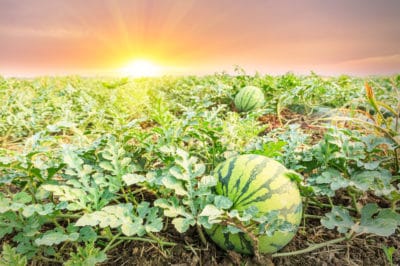Watermelons Long Cultivation History
Belonging in the large Cucurbitaceae family, which is the same family as cucumbers, pumpkins and squash, watermelons have been cultivated for thousands of years. Native to northeast Africa, evidence shows watermelons were cultivated and prized by the ancient Pharaohs’ of Egypt. They were so important, references to watermelons are found on the ancient hieroglyphics of Egypt and the fruits included in the Pharaohs’ tomb for their journey into the afterlife.
From Egypt, merchant ships introduced watermelons throughout the various countries along the Mediterranean, and from there it continued to spread. By the time the 10th Century rolled around, watermelons made their way to China, where they are still one of that country’s top produced fruit.
By the 13th Century, watermelons had been introduced to the rest of Europe. By the early 1500s, European colonists and African slaves brought the watermelon to the United States and were soon growing in Florida.
Seedless Watermelon History
The first seedless watermelon cultivar was developed in 1939 in Japan, but it wasn’t popular due to high susceptibility of disease. By the 21st Century, and due to continued breeding to develop more disease-resistant strains, seedless watermelons amount for 85 percent of all the watermelon sales in the U.S.
Preferred Climate
Watermelons, considered annual subtropical and tropical fruits, have a vining or scrambling nature, with most types requiring a large growing space or climbing structure, if grown in containers. The plants are very sensitive to frost and cold conditions. If seeds are sowed or transplants set out in the garden when outdoor air and soil temperatures are still too cold, they can fail to germinate or thrive.
Therefore, it’s imperative to wait until the weather warms in spring to plant outdoors. The prime conditions for planting include:
- The best temperatures for germination are between 70°F to 95°F (21.1°C to 35°C). Germination occurs in a couple of days, when seeds are planted in 95°F (35°C) and can take a week, when planted in 70°F (21.1°C).
- Watermelons thrive when planted and grown with temperatures ranging between 70°F and 85°F (21.1°C and 29.4°C), but still handle temperatures of 90°F (32.2°C).
Expert Tip: To get a jump on growing, you can start your watermelon seeds in peat pots about three weeks before your area’s last spring frost. Place the pots in a sunny window or other sunny and warm location indoors, and the seeds should start germinating in about a week.
Where to Plant
When deciding what variety of watermelon to plant, always consider your local weather conditions and the length of your warm-season. If you can only expect a little over two months of warm conditions, you don’t want to select a variety that takes over 100 days to ripen.
Always read the seed packet for important planting and growing information like days to expected harvest, size of ripe fruit and plants, planting depth and expected days to germination. The seed packet also tells you how much room you’ll need between multiple plants to give the watermelons their needed space to grow well.
Regardless of the color of the watermelon’s skin and fruit, size of the fruit and the length of time you have to wait until you harvest, all watermelons require the same basic growing conditions.
- A site located in full sun for the majority of the day.
- Fertile, well-drained soil with a pH of 6 to 6.5.
If growing you watermelon in a container, select a variety producing smaller melons and shorter plants. Smaller watermelons aren’t too heavy for trellising and shorter-growing plants work better for potted growth.
- Use a 5-gallon container that has bottom drainage.
- Fill the container with a rich, well-drained potting mix.
- A sturdy trellis or fence installed at the time of planting, so it doesn’t damage the sensitive root system.
- Suspend the developing fruit to the structure with a material like pantyhose.
Expert Tip: Keep seeds planted in pots and in the garden, as well as garden transplants watered regularly to keep the soil moist but not soggy. If your garden soil lacks the needed nutrients, amend the area with 6- to 8-inches of well-rotted manure or compost.
